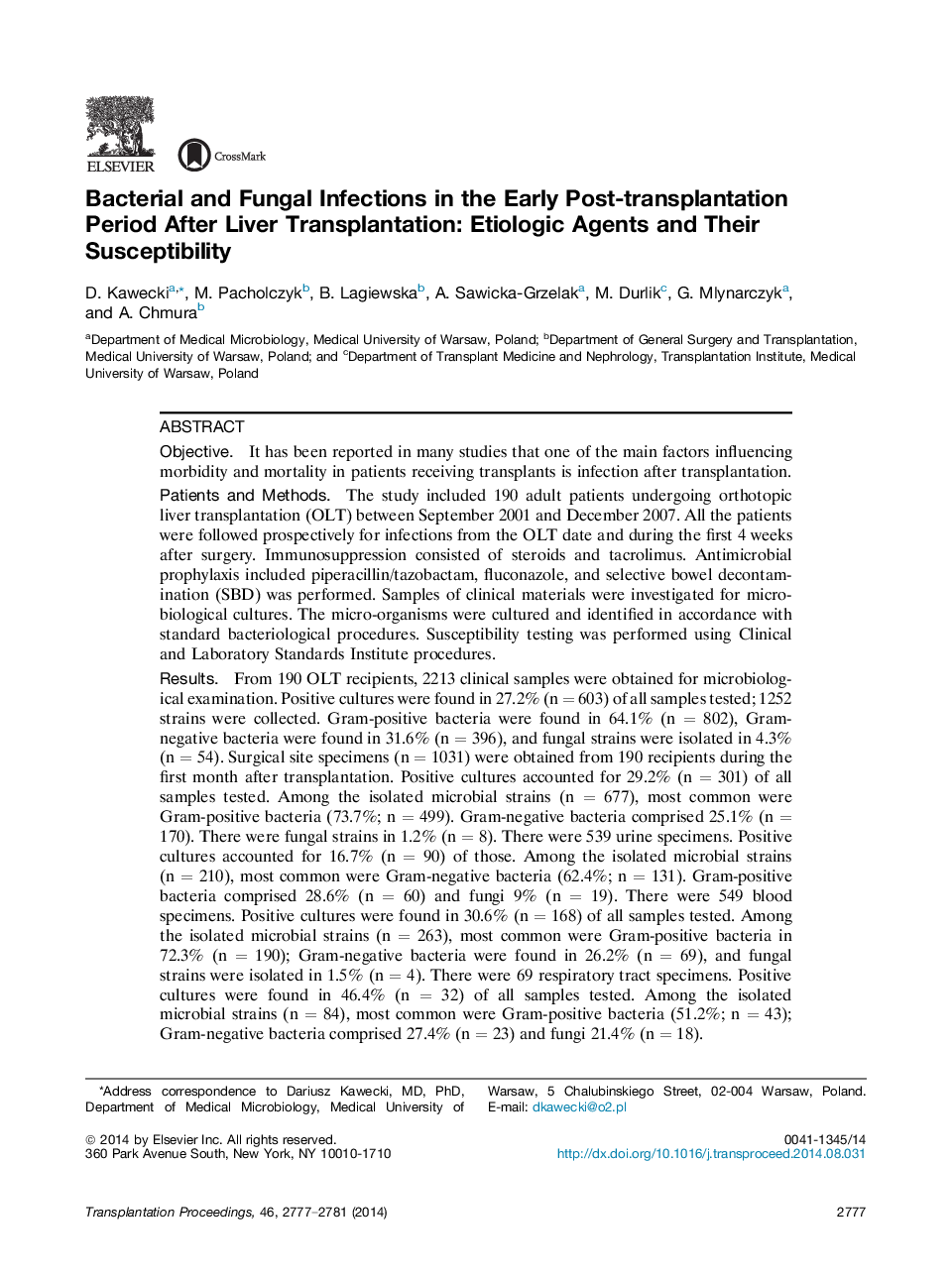| کد مقاله | کد نشریه | سال انتشار | مقاله انگلیسی | نسخه تمام متن |
|---|---|---|---|---|
| 4257984 | 1284552 | 2014 | 5 صفحه PDF | دانلود رایگان |
ObjectiveIt has been reported in many studies that one of the main factors influencing morbidity and mortality in patients receiving transplants is infection after transplantation.Patients and MethodsThe study included 190 adult patients undergoing orthotopic liver transplantation (OLT) between September 2001 and December 2007. All the patients were followed prospectively for infections from the OLT date and during the first 4 weeks after surgery. Immunosuppression consisted of steroids and tacrolimus. Antimicrobial prophylaxis included piperacillin/tazobactam, fluconazole, and selective bowel decontamination (SBD) was performed. Samples of clinical materials were investigated for microbiological cultures. The micro-organisms were cultured and identified in accordance with standard bacteriological procedures. Susceptibility testing was performed using Clinical and Laboratory Standards Institute procedures.ResultsFrom 190 OLT recipients, 2213 clinical samples were obtained for microbiological examination. Positive cultures were found in 27.2% (n = 603) of all samples tested; 1252 strains were collected. Gram-positive bacteria were found in 64.1% (n = 802), Gram-negative bacteria were found in 31.6% (n = 396), and fungal strains were isolated in 4.3% (n = 54). Surgical site specimens (n = 1031) were obtained from 190 recipients during the first month after transplantation. Positive cultures accounted for 29.2% (n = 301) of all samples tested. Among the isolated microbial strains (n = 677), most common were Gram-positive bacteria (73.7%; n = 499). Gram-negative bacteria comprised 25.1% (n = 170). There were fungal strains in 1.2% (n = 8). There were 539 urine specimens. Positive cultures accounted for 16.7% (n = 90) of those. Among the isolated microbial strains (n = 210), most common were Gram-negative bacteria (62.4%; n = 131). Gram-positive bacteria comprised 28.6% (n = 60) and fungi 9% (n = 19). There were 549 blood specimens. Positive cultures were found in 30.6% (n = 168) of all samples tested. Among the isolated microbial strains (n = 263), most common were Gram-positive bacteria in 72.3% (n = 190); Gram-negative bacteria were found in 26.2% (n = 69), and fungal strains were isolated in 1.5% (n = 4). There were 69 respiratory tract specimens. Positive cultures were found in 46.4% (n = 32) of all samples tested. Among the isolated microbial strains (n = 84), most common were Gram-positive bacteria (51.2%; n = 43); Gram-negative bacteria comprised 27.4% (n = 23) and fungi 21.4% (n = 18).Conclusions(1) Surgical site samples were predominated samples after LTx. (2) Our study showed Gram-positive bacteria were 64.1% (n = 802), Gram-negative bacteria, 31.6% (n = 396) and fungal strains isolated in 4.3% (n = 54). (3) The increased proportion of isolates of multi-drug–resistant bacterial strains (methicillin resistant coagulase negative Staphylococcus, vancomycin-resistant Enterococcus, high-level aminoglycoside resistance, and extended- spectrum β-lactamase). (4) These data indicate strict cooperation infection control procedures in these patients.
Journal: Transplantation Proceedings - Volume 46, Issue 8, October 2014, Pages 2777–2781
